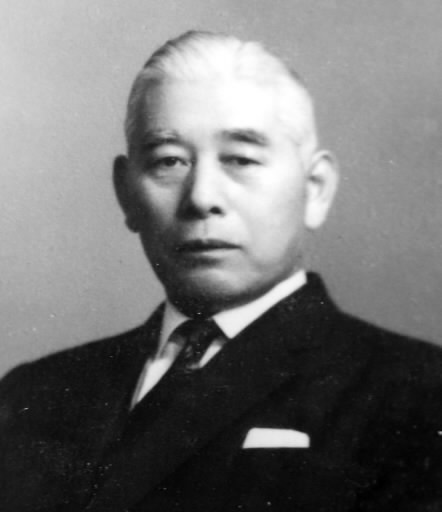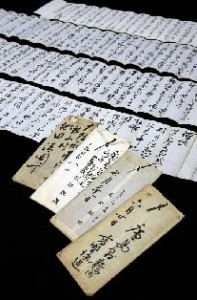Letters written by governor at time of A-bombing found: Genshin Takano frankly describes feelings of chagrin
Mar. 19, 2014
Missives stored at prefectural archives
by the “Appeals from Hiroshima” reporting team
Four letters written by Genshin Takano (1895-1969), who was governor of Hiroshima Prefecture at the time of the atomic bombing, have been found. The letters were written from the time of his appointment in June 1945 to October of that same year, when he stepped down. In the letters Mr. Takano writes of his efforts to address air defense and vividly describes his feelings as head of the prefectural government, which was thrown into unprecedented chaos by the atomic bombing. The letters were addressed to Kiyoshi Ikeda, governor of Osaka Prefecture. The two men had previously worked together at the Home Ministry. Researchers and others have hailed the letters as first-rate material for understanding developments before and after the atomic bombing. The Hiroshima Prefectural Archives have taken steps to have the letters stored at their facility.
Mr. Takano, a native of what is now the city of Aizu Wakamatsu in Fukushima Prefecture, served as vice governor of Osaka Prefecture before being appointed governor of Hiroshima Prefecture by the government on June 10, 1945.
The first of the four letters, dated June 20, emphasizes the governor’s haste to prepare for an air raid by the United States military. “This place is small and crowded, and there are a lot of small rivers,” he wrote. “Most of the buildings are made of wood, so if a fire breaks out it will be a nearly impossible situation. I’m very anxious about that.”
In the next letter, which was written on July 21, Mr. Takano said, “Only Hiroshima hasn’t incurred a lot of damage, so it’s all the more worrisome.” In the same letter he wrote about undertaking a full-scale effort to demolish buildings to create fire breaks. “I don’t know whether or not we’ll be able to get it done in time, but we’re carrying out the demolition of buildings on a large scale,” he said.
But in the atomic bombing on August 6, the prefectural offices in Kako-machi(now part of Naka Ward) and other administrative functions were destroyed.
The governor, who was in Fukuyama on business, returned to Hiroshima the following day. He established temporary prefectural government offices at the Higashi Police Station in Kanayama-cho, which had survived the devastation. He then directed the effort to aid the injured and ordered the release of provisions in the form of canned goods for 200,000 people.
The letter written after the atomic bombing is dated September 7 and was sent the next day from the prefectural offices, which had relocated to the premises of Toyo Kogyo (now Mazda).
After telling of his chagrin at Japan’s defeat and his determination to rebuild the nation, he described the devastation. “We’ve already lost 606 prefectural employees, and there will be a considerable number of deaths.” He frankly described his feelings, saying, “We cannot do anything for air defense.” In another part of the letter he wrote, “Scientific research may be the deciding factor in future wars.” Mr. Takano lost his wife Shinako, 40, in the A-bombing, but he makes no reference to that in the letters.
Mr. Takano was named chief of police on October 11, but he resigned in January 1946 with the issuance of an order by the General Headquarters of the Allied Forces prohibiting certain people from engaging in public service. Mr. Takano subsequently became a lawyer. He died of acute pneumonia at his home in Tokyo at the age of 73.
Mr. Takano’s son, Motoaki, 87, a resident of Kamakura in Kanagawa Prefecture, said, “My father never talked about his days as governor of Hiroshima Prefecture, and he left no records either. The letters have historical value, and I’ll be very pleased if they are preserved and put to good use in Hiroshima.”
Mr. Ikeda, to whom the letters were addressed, died in 1966. After his death the letters were kept by others. Their existence was revealed through a former employee of a prefectural office in charge of compiling historical documents.
First-rate material
A new chapter in A-bomb history
Mr. Takano’s letters were examined by Fukuhei Ando, 65, former vice director of the Hiroshima Prefectural Archives. He noted that as prefectural governor Mr. Takano was responsible for civil air defense, for which students were mobilized, and said that the letters frankly convey the governor’s feelings about that as well as his thoughts as a policymaker who faced the atomic bombing and Japan’s defeat in the war. Mr. Ando said that it was fair to say that the letters were first-rate material. Isei Otsuka, superintendent of the Chugoku Regional Superintendency-General, which administered the Chugoku Region, and Senkichi Awaya, mayor of Hiroshima, were killed in the A-bombing, so Mr. Takano was in charge of measures taken immediately after the end of the war, but he had been largely forgotten, Mr. Ando said. He said he hoped many people would look at the letters and learn about the history of Hiroshima.
(Originally published on March 17, 2014)
by the “Appeals from Hiroshima” reporting team
Four letters written by Genshin Takano (1895-1969), who was governor of Hiroshima Prefecture at the time of the atomic bombing, have been found. The letters were written from the time of his appointment in June 1945 to October of that same year, when he stepped down. In the letters Mr. Takano writes of his efforts to address air defense and vividly describes his feelings as head of the prefectural government, which was thrown into unprecedented chaos by the atomic bombing. The letters were addressed to Kiyoshi Ikeda, governor of Osaka Prefecture. The two men had previously worked together at the Home Ministry. Researchers and others have hailed the letters as first-rate material for understanding developments before and after the atomic bombing. The Hiroshima Prefectural Archives have taken steps to have the letters stored at their facility.
Mr. Takano, a native of what is now the city of Aizu Wakamatsu in Fukushima Prefecture, served as vice governor of Osaka Prefecture before being appointed governor of Hiroshima Prefecture by the government on June 10, 1945.
The first of the four letters, dated June 20, emphasizes the governor’s haste to prepare for an air raid by the United States military. “This place is small and crowded, and there are a lot of small rivers,” he wrote. “Most of the buildings are made of wood, so if a fire breaks out it will be a nearly impossible situation. I’m very anxious about that.”
In the next letter, which was written on July 21, Mr. Takano said, “Only Hiroshima hasn’t incurred a lot of damage, so it’s all the more worrisome.” In the same letter he wrote about undertaking a full-scale effort to demolish buildings to create fire breaks. “I don’t know whether or not we’ll be able to get it done in time, but we’re carrying out the demolition of buildings on a large scale,” he said.
But in the atomic bombing on August 6, the prefectural offices in Kako-machi(now part of Naka Ward) and other administrative functions were destroyed.
The governor, who was in Fukuyama on business, returned to Hiroshima the following day. He established temporary prefectural government offices at the Higashi Police Station in Kanayama-cho, which had survived the devastation. He then directed the effort to aid the injured and ordered the release of provisions in the form of canned goods for 200,000 people.
The letter written after the atomic bombing is dated September 7 and was sent the next day from the prefectural offices, which had relocated to the premises of Toyo Kogyo (now Mazda).
After telling of his chagrin at Japan’s defeat and his determination to rebuild the nation, he described the devastation. “We’ve already lost 606 prefectural employees, and there will be a considerable number of deaths.” He frankly described his feelings, saying, “We cannot do anything for air defense.” In another part of the letter he wrote, “Scientific research may be the deciding factor in future wars.” Mr. Takano lost his wife Shinako, 40, in the A-bombing, but he makes no reference to that in the letters.
Mr. Takano was named chief of police on October 11, but he resigned in January 1946 with the issuance of an order by the General Headquarters of the Allied Forces prohibiting certain people from engaging in public service. Mr. Takano subsequently became a lawyer. He died of acute pneumonia at his home in Tokyo at the age of 73.
Mr. Takano’s son, Motoaki, 87, a resident of Kamakura in Kanagawa Prefecture, said, “My father never talked about his days as governor of Hiroshima Prefecture, and he left no records either. The letters have historical value, and I’ll be very pleased if they are preserved and put to good use in Hiroshima.”
Mr. Ikeda, to whom the letters were addressed, died in 1966. After his death the letters were kept by others. Their existence was revealed through a former employee of a prefectural office in charge of compiling historical documents.
First-rate material
A new chapter in A-bomb history
Mr. Takano’s letters were examined by Fukuhei Ando, 65, former vice director of the Hiroshima Prefectural Archives. He noted that as prefectural governor Mr. Takano was responsible for civil air defense, for which students were mobilized, and said that the letters frankly convey the governor’s feelings about that as well as his thoughts as a policymaker who faced the atomic bombing and Japan’s defeat in the war. Mr. Ando said that it was fair to say that the letters were first-rate material. Isei Otsuka, superintendent of the Chugoku Regional Superintendency-General, which administered the Chugoku Region, and Senkichi Awaya, mayor of Hiroshima, were killed in the A-bombing, so Mr. Takano was in charge of measures taken immediately after the end of the war, but he had been largely forgotten, Mr. Ando said. He said he hoped many people would look at the letters and learn about the history of Hiroshima.
(Originally published on March 17, 2014)









